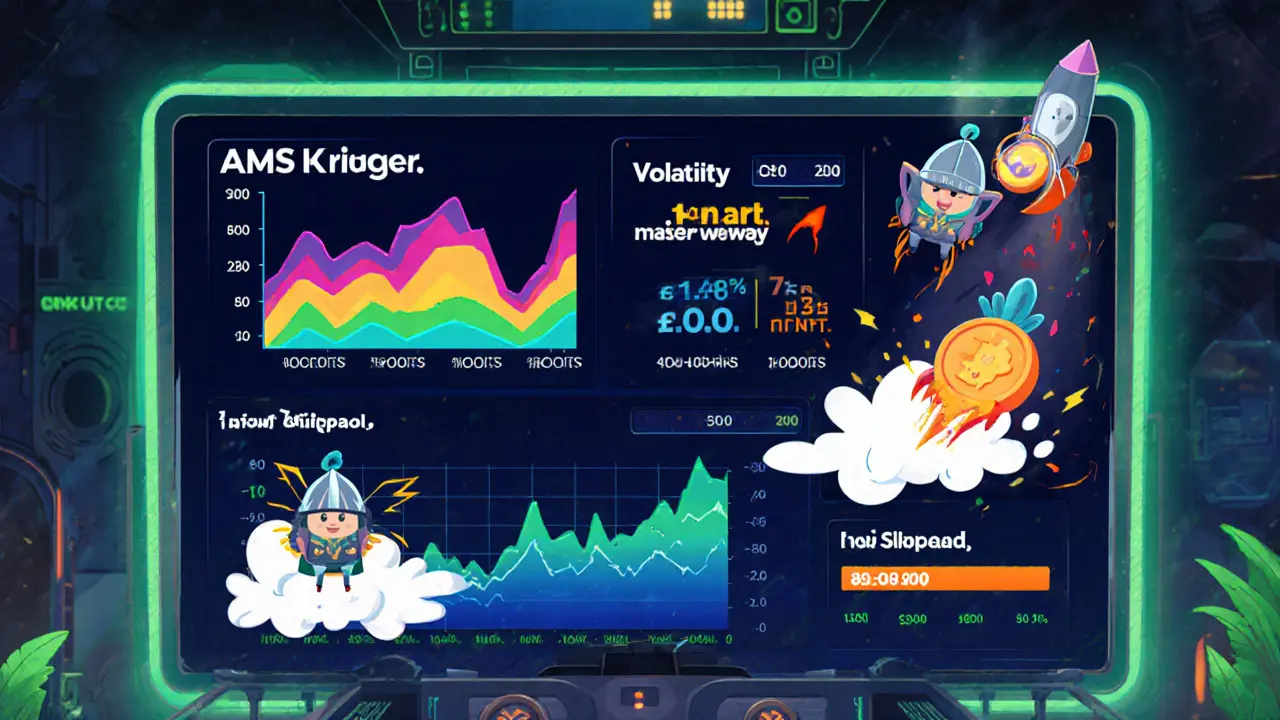
- 29 Jul 2025
- Elara Crowthorne
- 15
Camelot DEX Fee Calculator
Enter values and click "Calculate Trading Costs" to see fee comparisons
Camelot (Arbitrum)
- Spot 0.00% Base Fee
- Limit 0.00% Base Fee + Gas
- Liquidity 0.00% Fee + Rewards
Lowest fees on Arbitrum ecosystem
Uniswap (Arbitrum)
- Spot 0.30% Base Fee
- Limit 0.30% Base Fee + Gas
- Liquidity 0.30% Fee + Rewards
Standard V3 pricing model
Binance (Centralized)
- Spot 0.10% - 0.25% Base Fee
- Limit 0.10% - 0.25% Base Fee + Gas
- Liquidity 0.10% - 0.25% Fee + Rewards
High-volume centralized exchange
If you’ve been hunting for a decentralized exchange that feels built for the Arbitrum ecosystem, you’ve probably heard the name Camelot a layer‑2 DEX launched in December2022 that runs on the Arbitrum network. This Camelot review breaks down what the platform actually does, how its fee model compares to the big players, and whether its native token GRAIL a capped‑supply governance token that lives on Arbitrum is worth your attention.
What is Camelot and why does it matter?
Camelot isn’t just another copy‑cat of Uniswap. It was created to be the “go‑to” DEX for Arbitrum developers, offering concentrated liquidity via the Algebra V2 a codebase that enables users to provide liquidity in narrow price ranges, improving capital efficiency. By moving away from pure yield‑farm incentives, Camelot aims to provide a sustainable trading layer that can grow alongside the layer‑2 scaling solution.
Core features you’ll actually use
- Automated Market Maker (AMM) with dynamic, volatility‑based fees.
- Limit order support - you can set a price target instead of relying on instant swaps.
- Compatibility with rebasing tokens, so projects like sAMM a rebasing token on Arbitrum work without hiccups.
- Customizable tick spacing per pool, allowing fine‑tuned price granularity.
- Specialized NFTs (spNFT NFTs that represent a position in a liquidity pool and can be transferred) and Nitro pools high‑throughput pools designed for low slippage and fast execution.
Supported assets and fee structure
The platform lists between 90and137 tokens, depending on the data source, covering major coins (ETH, USDC, WBTC) and a steady stream of Arbitrum‑native projects. The minimum deposit is only $1, so you can test‑drive the DEX without a big bankroll.
Fees are arguably the most eye‑catching part of the review. According to FxVerify, the taker and maker rates sit at 0.00% for standard spot swaps - a stark contrast to centralized exchanges that charge 0.1‑0.25% per trade. Traders Union notes that fees can vary by transaction type (e.g., limit orders may incur a small gas‑related surcharge), but the baseline remains far lower than the norm.

Governance token ecosystem: GRAIL and xGRAIL
The governance token GRAIL capped at 100,000 tokens, minted on Arbitrum and used for platform incentives can be earned by staking in incentivized pools. Holding xGRAIL the derivative token that grants voting power in the Camelot DAO gives you a say in protocol upgrades, fee changes, and new pool listings. The voting process is gas‑less - the DAO aggregates signatures off‑chain and only executes approved proposals on‑chain, keeping participation cheap.
Price forecasts from CoinLore range from $999.57 to $1,616 by the end of 2025, with longer‑term bull scenarios pushing toward $3,859 by 2030. These numbers are speculative, but they illustrate the market’s bullish sentiment around governance‑driven token models.
User experience: onboarding in minutes
- Install a Web3 wallet that supports Arbitrum (MetaMask, Trust Wallet, etc.).
- Switch the network to Arbitrum in the wallet settings.
- Visit the Camelot web UI - there’s no mobile app yet, but the site is fully responsive.
- Click “Connect Wallet” and approve the connection prompt.
- Select the token pair, set the amount, and hit “Swap”. For limit orders, choose “Limit” and set your price.
The average session lasts about a minute, with a bounce rate of 49% and roughly 1.7 pages per visit - users tend to complete trades quickly and exit, which suggests a streamlined UI.
Security and regulatory outlook
Being a DEX, Camelot runs on immutable smart contracts. No central custodial account means the platform itself can’t be hacked in the traditional sense, but users remain exposed to smart‑contract bugs. The codebase has been audited by multiple firms, though the audits are not publicly archived on the site - a transparency gap worth noting.
Regulation is another gray area. Camelot does not hold a license from any financial authority, which is typical for DeFi projects. This lack of oversight gives you freedom, but also means there’s no recourse if something goes wrong.
How Camelot stacks up against the competition
| Feature | Camelot | Binance | Uniswap (Arbitrum) |
|---|---|---|---|
| Network | Arbitrum Layer‑2 | Multiple (centralized) | Arbitrum Layer‑2 |
| Supported Tokens | ≈130 (incl. Arbitrum natives) | ~500+ (global) | ≈120 (Arbitrum list) |
| Base Trading Fee | 0.00% (spot) | 0.10%‑0.25% | 0.30% |
| Concentrated Liquidity | Yes (AlgebraV2) | No | Yes (V3) |
| Governance Token | GRAIL / xGRAIL | BNB | UNI |
| Mobile App | No (web‑only) | Yes | Yes (via third‑party) |
| Regulatory Status | Unregulated (DeFi) | Licensed in multiple jurisdictions | Unregulated (DeFi) |
In short, Camelot wins on fee‑efficiency and tailored Arbitrum features, while Binance still dominates on sheer volume and asset breadth. Uniswap offers similar liquidity mechanics but charges a higher base fee.

Pros, cons, and who should use Camelot
- Pros
- Zero‑percent baseline fees - great for low‑value swaps.
- Concentrated liquidity lowers slippage for active traders.
- GRAIL incentives align community interests.
- Simple web UI works on any desktop browser.
- Cons
- No mobile app yet - not ideal for on‑the‑go trading.
- Limited token list compared to mega‑exchanges.
- Regulatory uncertainty could deter risk‑averse investors.
- Best for
- Arbitrum developers looking to provide liquidity.
- Traders who value low fees over a massive asset roster.
- Community‑oriented investors who want governance participation.
Future outlook: where is Camelot headed?
The platform’s roadmap highlights ongoing improvements to the AMM engine, more Nitro‑pool deployments, and expanded spNFT utilities (e.g., using positions as collateral). As Arbitrum’s TVL climbs past $12billion, Camelot stands to capture a larger share of the layer‑2 swap market. The biggest risk is competition from newer DEXes that might copy the Algebra V2 code and undercut fees.
If the community continues to earn GRAIL through staking and the governance process stays gas‑less, user‑driven upgrades could keep the platform ahead of the curve. In a world where DeFi regulation tightens, Camelot’s decentralized nature could be both a selling point and a legal headache - it’s a trade‑off you’ll need to weigh.
Getting started in three steps
- Set up an Arbitrum‑compatible wallet. Add the Arbitrum network manually if your wallet doesn’t list it.
- Bridge assets. Use the official Arbitrum bridge or a trusted third‑party to move ETH, USDC, or other tokens onto Layer2.
- Swap or provide liquidity. On Camelot’s UI, choose a pair, decide between a standard swap or a limit order, and confirm the transaction in your wallet.
That’s it - you’re now part of the fastest‑growing DEX on Arbitrum.
Frequently Asked Questions
Is Camelot safe to use?
Safety on a DEX hinges on smart‑contract integrity. Camelot’s code has been audited by several firms, and the platform runs on the well‑tested Arbitrum rollup. However, because there’s no custodial protection, you must manage your private keys and double‑check contract addresses to avoid phishing traps.
How do I earn GRAIL?
GRAIL is distributed as a reward for providing liquidity in incentivized pools. Once you stake your LP tokens, you’ll receive GRAIL on a weekly schedule. You can also earn xGRAIL by locking GRAIL, which then grants voting power.
Can I trade on Camelot from a mobile browser?
Yes, the web interface is fully responsive, so a mobile browser works fine. Just make sure your wallet extension (e.g., MetaMask Mobile) is active and connected to Arbitrum.
What fees will I actually pay?
Baseline trading fees are 0% for spot swaps. Limit orders and some specialized pool interactions may incur a small gas cost, but overall the fee bill is dramatically lower than on centralized exchanges.
Is there any customer support?
Camelot relies on community channels - Discord, Telegram, and a public GitHub for bug reports. There’s no traditional ticket system, so response times vary.

15 Comments
Wow, diving into Camelot feels like stepping onto a grand stage where every trader becomes a heroic protagonist! The zero‑percent base fee is practically a gift from the blockchain gods, allowing newcomers to dip their toes without fear of bleeding cash. Its Algebra V2 engine, with concentrated liquidity, slices slippage like a master chef carving a perfect fillet. The limit order feature adds a layer of strategic depth that turns a simple swap into a chess move, rewarding patience and foresight. Moreover, the native GRAIL token offers a tantalizing glimpse of governance power, letting holders steer the platform’s destiny. With a token list hovering around 130, Camelot strikes a sweet balance between variety and focus, avoiding the overwhelm of mega‑exchanges. The UI is sleek, responsive, and intuitive, meaning even a crypto‑newbie can execute trades in under a minute. Audits by multiple firms provide a comforting blanket of security, though transparency could still improve. The community‑driven, gas‑less voting model democratizes decision‑making, aligning incentives across the board. As Arbitrum’s TVL surges beyond $12 billion, Camelot stands ready to capture a larger slice of the layer‑2 market. Its roadmap promises Nitro‑pools and expanded spNFT utilities, hinting at even more innovation. While the lack of a mobile app may irk on‑the‑go traders, the web‑only approach ensures broad accessibility across devices. Regulatory gray areas remain, but that very uncertainty fuels the DeFi spirit of independence. In short, Camelot isn’t just another DEX; it’s a vibrant ecosystem that rewards low‑cost, high‑efficiency trading while inviting users to shape its future. So strap in, explore the low‑fee frontier, and let Camelot become your launchpad to limitless possibilities.
Honestly, the hype around “zero fees” can be a bit misleading; you still pay gas, and on Arbitrum that’s not negligible during peak times. Still, compared to Uniswap’s 0.30% base, Camelot looks like a solid alternative for those who trade small amounts often.
While the article paints a rosy picture, it glosses over the fact that Camelot’s token incentives could be a double‑edged sword, potentially inflating GRAIL prices without delivering real utility. Also, the limited token list may deter serious traders seeking depth.
Oh great, another “zero‑fee” platform that will probably implode once the novelty wears off. If you enjoy watching hype cycles, sure, give it a spin.
i think its kinda cool how camelot let you start with just $1, thats really friendly for newbies. but i wish they had more tokens like some of the smaller arbi projects.
In reference to the preceding critique, it is pertinent to acknowledge that the platform’s audit reports, albeit not publicly archived, have been reaffirmed through third‑party attestations. Consequently, while the token ecosystem remains nascent, the underlying infrastructure demonstrates commendable resilience and operational efficiency.
Did anyone notice that Camelot’s code is basically a copy of Uniswap V3? Looks like they’re just rebranding the same tech while pretending it’s something revolutionary. I bet the “zero fees” claim is a trap to lure unsuspecting users into giving away their private keys.
Zero fees, zero problem.
From a protocol engineering standpoint, Camelot’s adoption of the Algebra V2 AMM model introduces granular tick spacing, which optimizes capital efficiency for high‑frequency liquidity providers. The integration of spNFTs also adds a novel composability layer for position tokenization.
Interesting point!; however, let’s not forget that gas costs on Arbitrum, while lower than Ethereum mainnet, can still be volatile-especially during periods of network congestion; thus, “zero‑percent” fees might give a false sense of cost‑effectiveness!
Camelot’s emphasis on community governance is a refreshing departure from the centralized control seen on many exchanges. If you’re new to DeFi, start with a small amount, bridge it to Arbitrum, and explore the limit order feature to get a feel for price targeting.
Indeed, the strategic advantages of low‑fee trading on a layer‑2 solution cannot be overstated; it democratizes access and fosters a more inclusive financial ecosystem. Moreover, the philosophical underpinnings of decentralized governance align with broader aspirations for economic liberty.
Only the truly enlightened can see past the superficial allure of “zero fees” to the deeper, almost spiritual, empowerment that Camelot offers-if you’re not, you’re just another pawn in the game. 🌟
Hey folks, if you’re looking for a friendly place to learn, Camelot’s UI is pretty straightforward. Feel free to ask any questions; we’re all here to help each other succeed.
Totally agree, the interface feels clean and the low fees are a big plus for casual traders like me.